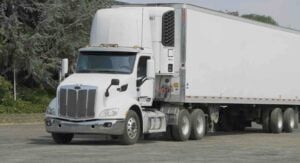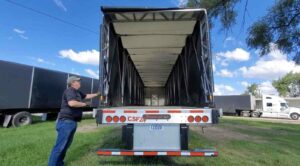Unlock The Power Of Dry Van Freight Shipping, Where Efficiency Meets Reliability And Your Cargo Arrives On Time.
The ins & outs of
Servicing, Managing and Helping you save
In the fast-paced world of logistics services, choosing the most efficient and dependable way to deliver your goods is vital. Dry van freight shipping has changed the way firms ship freight.
We’ll explore the inner workings, benefits, and best practices in this complete guide.
If you’re seeking a comprehensive understanding of LTL flatbed, reefer, dry van trucking services and how Paige Logistics potential to streamline your logistics operations, you’ve come to the right place.
Whether you’re a logistics professional or a business owner, this article can help you handle dry van shipments.
From understanding capacity to picking the right carrier and cargo safety, we’ll do everything. Cost, pricing, and industry developments will also be discussed.
We’ll reveal the secrets of successful dry van transportation and empower you to make the finest shipping logistics decisions to obtain the best dry van freight rates. So, we’ll change intermodal freight transport together.
What is a Dry Van?
Picture this: you’ve got goods, products, or merchandise that need to be moved from one place to another – it could be across town or clear across the country. And this is where the dry van swoops in to save the day.
Imagine a big, sturdy metal box on wheels, just like a trailer, that’s designed to carry your cargo safely and securely. No frills, no spills – just a reliable container that keeps your stuff shielded from the elements and the uncertainties of the road.
So, what sets a dry van apart from other types of trailers?
Well, it’s all in the name – “dry.” This bad boy is built to keep your goods dry and protected from rain, snow, sleet, and any other type of weather that Mother Nature might throw its way.
Think of it as a fortress on wheels, guarding your cargo against the elements as it barrels down highways and winds its way through bustling cities.
Inside that sleek metal shell, you’ve got a blank canvas of space. That means you can pack your products in boxes, pallets, or any other packaging that suits your fancy.
The versatility of a dry van is one of its prime advantages. Whether you’re moving electronics, clothing, consumer goods, or even non-perishable food items, this trusty container is up for the task.
Now, I know what you’re thinking – “Alex, what about loading and unloading?” Well, my friends, that’s the beauty of it.
Dry vans are designed to be compatible with loading docks, making the process smooth as butter. Forklifts and pallet jacks can easily glide in and out, making the chore of loading and unloading a breeze. Efficiency is the name of the game, and dry vans are here to play. Read more below…
What is Dry Van Shipping?
Dry van freight shipping, which transports goods in enclosed trailers, is common. These trailers keep cargo safe and secure during transport. Dry van shipment is convenient and reliable for firms shipping a variety of items.
How does dry van shipping work?
Dry van transport has many steps. To protect the cargo, the dry van trailer is loaded and sealed. After arriving, the trailer is unloaded. This technique expedites delivery and protects products from weather and harm.
How to Choose a Dry Van Carrier?
When deciding on a dry van shipping provider, it is important to consider factors such as:
- Reputation: Research the provider’s reputation on Clutch for solid reliability, on-time deliveries, and customer satisfaction.
- Coverage: Ensure that the logistics company offers services in your area to meet your shipping needs effectively.
- Maintenance: Verify that the carrier maintains their dry van trailers in top condition to minimize the risk of breakdowns or delays.
Best Practices for Efficient Dry Van Shipping
To maximize efficiency in dry van shipping, consider implementing the following:
- Cargo Safety: Proper packaging and palletize goods to prevent damage during transportation.
- Load Planning: Optimize space utilization within the trailer by strategically arranging and securing the cargo. Utilize proper securing techniques such as straps, dunnage, or load bars to minimize shifting and ensure cargo stability.
- Communication: Maintain open lines of communication with the shipping provider to ensure smooth coordination and minimize delays.
- Insurance: Obtain comprehensive insurance coverage to protect against unforeseen circumstances or accidents during transit.
Benefits of Dry Van Freight Shipping
- Versatility: Dry van trailers can accommodate a variety of products, including packaged items and palletized cargo, making them a versatile option for a variety of industries.
- Protection: The enclosed nature of dry van trailers protects goods from external factors such as weather, dust, and debris, ensuring that they reach in pristine condition.
- Security: The increased security measures provided by dry van transportation reduce the risk of theft or damage during transit.
- Affordability: Since vehicles are readily available with dry van shipping, it is simpler to save money compared to other freight transport methods. Additionally, dry vans do not require additional features like refrigerated containers. Even for long-distance shipments, it is one of the most economical transportation methods available.
- Drop and Hook: Instead of waiting for the cargo to be unloaded at the destination, the driver can simply drop off the loaded dry van trailer and collect up one that has already been loaded. This eliminates the need for lengthy waiting periods, reduces labour requirements, and expedites the turnover time.
Streamlining Efficiency in Dry Van Shipping
One of the significant benefits of dry van shipping is the drop and hook options capacity for operations. This streamlined approach offers numerous advantages for businesses seeking efficient freight transport.
Let’s explore how the drop and hook option enhances the effectiveness of dry van shipping:
- Time and Labor Savings: With drop and hook, the process of loading and unloading becomes more efficient. Instead of waiting for the cargo to be unloaded at the destination, the driver can simply drop the loaded trailer and pick up a pre-loaded one. This eliminates the need for extensive wait times, reduces labor requirements, and ensures a quicker turnaround.
- Increased Flexibility: Drop and hook provides greater flexibility for businesses by allowing them to schedule shipments according to their convenience. With pre-loaded trailers readily available, it becomes easier to coordinate pick-ups and deliveries, adapt to changing customer demands, and optimize transportation routes.
- Minimized Downtime: The drop and hook option helps minimize downtime for drivers. Instead of spending valuable time at the destination for unloading, they can quickly exchange trailers and proceed to their next assignment. This translates to improved driver productivity and overall operational efficiency.
- Enhanced Security: By eliminating the need for drivers to wait at the destination during unloading, the drop and hook method enhances security. Trailers remain sealed and secure throughout the transportation process, reducing the risk of cargo tampering or theft.
By incorporating the drop and hook option into dry van freight shipping services, businesses can benefit from time savings, increased flexibility, minimized downtime, enhanced security, and streamlined operations.
This efficient approach adds value to the transportation process, enabling businesses to meet their logistics needs effectively and maintain a competitive edge in the market.
Pricing Dry Van Shipping
When evaluating costs, factors to consider include:
- Distance: Longer distances typically incur higher transportation costs.
- Freight Volume: Higher volumes of cargo may lead to better pricing options.
- Additional Services: Special services such as expedited shipping or dedicated trailers may come at an additional cost.
Dry Van Shipping vs. Other Freight Transportation Methods
When evaluating the best transportation method for your cargo, it’s essential to compare dry van shipping with other available options. Let’s examine how dry van shipping stacks up against alternative freight transportation methods:
- Flatbed Shipping: Dry van trailers provide enclosed and secure transportation, protecting your cargo from external elements such as weather conditions, dust, and debris. This makes dry van shipping ideal for standard-sized and packaged goods that require additional protection.Flatbed Shipping: Flatbed trailers, on the other hand, offer an open platform without walls or roof, making them suitable for oversized or irregularly shaped cargo. This method is commonly used for transporting construction materials, heavy machinery, or large equipment.
- Refrigerated (Reefer) Shipping: Dry van shipping is ideal for general freight that does not require temperature-controlled conditions. It is a cost-effective solution for industries such as retail, consumer goods, and non-perishable goods.Refrigerated Shipping: Reefer trailers, equipped with cooling systems, maintain controlled temperatures to transport perishable or temperature-sensitive goods such as fresh produce, pharmaceuticals, or frozen food. This ensures the integrity and quality of the cargo throughout the journey.
- LTL (Less-Than-Truckload) Shipping: LTL dry van freight shipping is often used for full truckload shipments, where the entire trailer is dedicated to a single customer’s goods. It offers maximum space utilization and is suitable for businesses with larger shipment volumes or when specific delivery timelines are required. LTL shipping involves consolidating smaller shipments from multiple customers into a single trailer. This method is cost-effective for businesses with smaller cargo volumes or when flexibility in delivery schedules is acceptable. Learn about how to prepare your LTL freight classification
- Intermodal Shipping: Dry van container shipping provides seamless transportation from origin to destination using a single mode of transportation, typically road-based. It offers door-to-door delivery and is suitable for various industries.Dry Van vs Container – Intermodal shipping container involves the use of multiple modes of transportation, such as rail, truck, or sea. It offers cost savings, environmental benefits, and efficient long-distance transportation, making it a preferred choice for international or cross-country shipments.

Author & Chief Executive Officer at Paige Logistics Ltd. → Experienced Operations Manager with a demonstrated history of working in the Transportation, Trucking and the Railroad Industry.


































